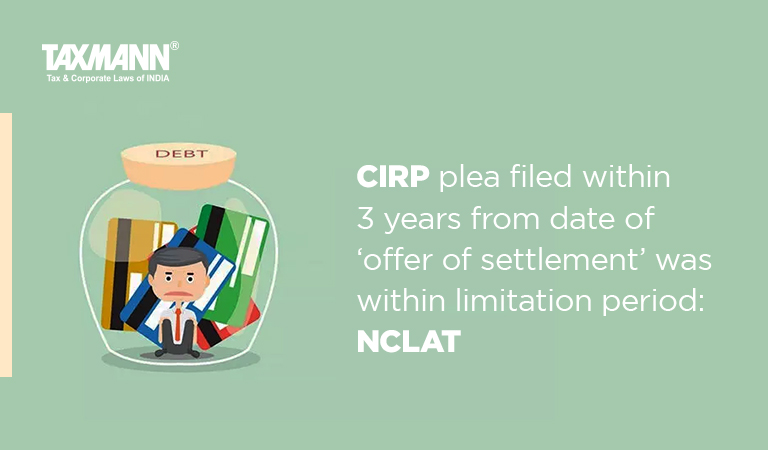CIRP plea filed within 3 years from date of ‘offer of settlement’ was within limitation period: NCLAT
- Blog|News|Insolvency and Bankruptcy Code|
- 3 Min Read
- By Taxmann
- |
- Last Updated on 4 March, 2022
Case Details: Vivekanand Jha v. Punjab National Bank - [2021] 131 taxmann.com 221 (NCLAT- New Delhi)
Judiciary and Counsel Details
-
- Justice A.I.S. Cheema, Officiating Chairperson and Dr. Alok Srivastava, Technical Member
- Adhitya Srinivasan and Rahul Patel, Advs. for the Appellant.
- Jigar Tarunkumar Bhatt, and Abhinav Thareja, Advs. for the Respondent.
Facts of the Case
The financial creditor-bank had approved various financial facilities and disbursed loans in the form of cash credit and overdraft facilities dated 6-3-2013 to the corporate debtor but the corporate debtor did not pay the instalments as per the agreement. As a result, the bank filed proceedings before the Debts Recovery Tribunal. A notice under section 13(2) of the SARFAESI Act, 2002 was also issued to the corporate debtor when the loan account became non-performing assets. The date of default was 27-12-2014.
In the meantime, the bank filed an application under section 7 of the Insolvency and Bankruptcy Code, 2013 before NCLT claimed outstanding dues.
Before the Adjudicating Authority, the appellant-corporate debtor raised defence that the claim made by the bank was time-barred, it was claimed that in a notice under section 13(2) of the SARFAESI Act, NPA was stated to be dated 29-12-2014 and in an application under section 7 date of default was stated to be dated 27-12-2014.
Therefore, the NCLT by the impugned order held that there was no dispute on the fact that the corporate debtor had committed default in paying the financial debt more than Rupees One lakh which is the threshold under section 4 of the IBC, to the financial creditor. NCLT admitted the application under section 7 by the impugned order.
NCLAT Held
On appeal, the appellant had referred to Annexure A-2 relating to the cash credit facility on term loan approved by the bank to state that the cash credit facility was accepted to the extent of Rupees Six Crores but if the form for filing the application under section 7 was perused, it shows that the outstanding shown towards balance was Rs. 5,99,73,485. Thus, it was argued that the appellant still was within the cash credit limit. It was argued that the corporate debtor was paying the interest and installments and the account was wrongly shown as NPA. It was also argued that the notice under section 13 of the SARFAESI Act issued to the corporate debtor by the bank was not upheld in DRT up to the High Court.
However, the NCLAT found that an Offer of Settlement (OTS) was entered between parties on 29-3-2016, which failed in execution. Since OTS had been accepted and signed by directors of a corporate debtor, OTS would amount to acknowledgment.
Since acknowledgment was there, an application filed on 12-2-2019 was within limitation and, thus, NCLT was justified in admitting the application and rejecting the claim of the corporate debtor that the application was time-barred.
Case Review
-
- Innoventive Industries Ltd. v. ICICI Bank [2017] 84 taxmann.com 320/143 SCL 625 (SC) (para 10)
- Sesh Nath Singh v. Baidyabati Sheoraphuli Co-operative Bank Ltd. [2021] 125 taxmann.com 357/166 SCL 507 (SC) (para 13)
- Asset Reconstruction Co. (India) Ltd. v. Bishal Jaiswal [2021] 126 taxmann.com 200/166 SCL 82 (SC) (para 13) followed.
- Punjab National Bank v. Mithilanchal Industries (P.) Ltd. [2021] 131 taxmann.com 220 (NCLT – Ahmedabad) (para 14) affirmed
List of Cases Referred to
-
- Innoventive Industries Ltd. v. ICICI Bank [2017] 84 taxmann.com 320/143 SCL 625 (SC) (para 10)
- Sesh Nath Singh v. Baidyabati Sheoraphuli Co-operative Bank Ltd. [2021] 125 taxmann.com 357/166 SCL 507 (SC) (para 13)
- Asset Reconstruction Co. (India) Ltd. v. Bishal Jaiswal [2021] 126 taxmann.com 200/166 SCL 82 (SC) (para 13) followed.
Disclaimer: The content/information published on the website is only for general information of the user and shall not be construed as legal advice. While the Taxmann has exercised reasonable efforts to ensure the veracity of information/content published, Taxmann shall be under no liability in any manner whatsoever for incorrect information, if any.

Taxmann Publications has a dedicated in-house Research & Editorial Team. This team consists of a team of Chartered Accountants, Company Secretaries, and Lawyers. This team works under the guidance and supervision of editor-in-chief Mr Rakesh Bhargava.
The Research and Editorial Team is responsible for developing reliable and accurate content for the readers. The team follows the six-sigma approach to achieve the benchmark of zero error in its publications and research platforms. The team ensures that the following publication guidelines are thoroughly followed while developing the content:
- The statutory material is obtained only from the authorized and reliable sources
- All the latest developments in the judicial and legislative fields are covered
- Prepare the analytical write-ups on current, controversial, and important issues to help the readers to understand the concept and its implications
- Every content published by Taxmann is complete, accurate and lucid
- All evidence-based statements are supported with proper reference to Section, Circular No., Notification No. or citations
- The golden rules of grammar, style and consistency are thoroughly followed
- Font and size that’s easy to read and remain consistent across all imprint and digital publications are applied








 CA | CS | CMA
CA | CS | CMA


